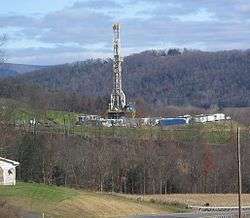Produced water

Produced water is a term used in the oil industry to describe water that is produced as a byproduct along with the oil and gas. Oil and gas reservoirs often have water as well as hydrocarbons, sometimes in a zone that lies under the hydrocarbons, and sometimes in the same zone with the oil and gas.
Oil wells sometimes produce large volumes of water with the oil, while gas wells tend to produce water in smaller proportion.
To achieve maximum oil recovery, waterflooding is often implemented, in which water is injected into the reservoirs to help force the oil to the production wells. The injected water eventually reaches the production wells, and so in the later stages of waterflooding, the produced water proportion ("cut") of the total production increases.
Water quality
Much produced water is brine, and has total dissolved solids too high for use as drinking water or in agriculture. Some produced water contains heavy metals and traces of naturally occurring radioactive material (NORM), which over time deposits radioactive scale in the piping at the well.[1][2] Metals found in produced water include zinc, lead, manganese, iron, and barium.[3]:8
Water management
Historically, produced water was disposed of in large evaporation ponds. However, this has become an increasingly unacceptable disposal method from both environmental and social perspectives. Produced water is considered an industrial waste and coal seam gas (CSG) producers are now required to employ beneficial re-uses for produced water.
The broad management options for re-use are direct injection, environmentally acceptable direct-use of untreated water, or treatment to a government-issued standard before disposal or supply to users. In the United States these standards are issued by the U.S. Environmental Protection Agency (EPA) for underground injection[4][5] and discharges to surface waters.[6]
Dissolved gas flotation, plate coalescers and gravity separators are some of the technologies used in treating wastes from produced water.[7]
See also
References
- ↑ "About Produced Water". Advanced Water Technology Center. Golden, CO: Colorado School of Mines. Retrieved 2016-05-14.
- ↑ Igunnu, Ebenezer T.; Chen, George Z. (2012-07-04). "Produced water treatment technologies". Int. J. Low-Carbon Tech. Oxford University Press. 2014 (9): 157. doi:10.1093/ijlct/cts049.
- ↑ Veil, John A.; Puder, Markus G.; Elcock, Deborah; Redweik, Robert J. (2004). A white paper describing produced water from production of crude oil, natural gas, and coal bed methane (PDF) (Report). Argonne, IL: US Argonne National Laboratory. ANL/EA/RP-112631.
- ↑ U.S. Environmental Protection Agency (EPA), Washington, DC (2015). "Underground Injection Control Regulations and Safe Drinking Water Act Provisions."
- ↑ EPA (2015). "General Information About Injection Wells."
- ↑ EPA (2016). "Oil and Gas Extraction Effluent Guidelines."
- ↑ Development Document for Final Effluent Limitations Guidelines and New Source Performance Standards for the Offshore Subcategory of the Oil and Gas Extraction Point Source Category (Report). EPA. 1993. pp. IX–15–IX–19. EPA-821-R-93-003.